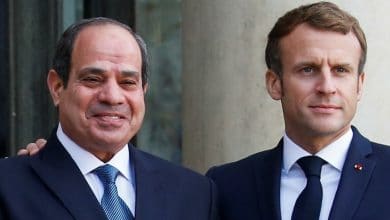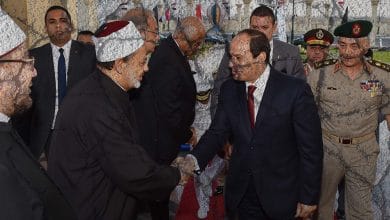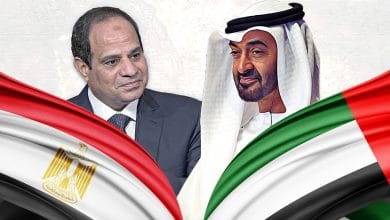
None of the military personnel that participated in repelling the tripartite aggression on Egypt in 1956 or the Six Day War (1967), known as the Naksa (setback) or even the October 1973 War – none of them has ever imagined that in April 2016, head of the Egyptian regime, General Abdel Fattah al-Sisi, would announce waiver of Egypt’s sovereignty over the Tiran and Sanafir Red Sea islands to the Kingdom of Saudi Arabia, turning the six-kilometer-wide Strait of Tiran (between the Egyptian mainland and Tiran Island) into an international waterway, an Israeli dream that has been achieved thanks to Tel Aviv’s new partners: Mohammed bin Salman and Abdel Fattah al-Sisi.
Over the years that followed Egypt’s military coup on July 3, 2013, Sisi has received many grants and loans from Saudi Arabia (and the UAE). However, after the access of Mohammed bin Salman to power as Crown Prince, Riyadh has injected more funds into Egypt, part of which were allocated for development projects in the Sinai Peninsula.
In light of the US-led Bahrain Conference held in Manama for two days (25, 26 June), entitled “Peace to Prosperity Workshop”, this paper will monitor the Saudi grants and loans related to the Sinai Peninsula, their dimensions, and their interrelatedness with the ‘deal of the century’ that is being prepared.
Illusion
The “King Salman Bridge” is the project that was announced by King Salman during the second day of his visit to the Egyptian capital, Cairo in April 2016. At the time, King Salman described the visit as historical and said in a statement that the bridge would connect Asia and Africa and would contribute to boosting commerce between the two allying countries and the two continents. In addition, the bridge, which is likely to serve as a major crossing for pilgrims, will also act as an international outlet for promising projects between the two countries. The name given to the intended bridge was reportedly suggested by head of the Egyptian regime Abdel Fattah Al-Sisi.
Some considered that the announcement of the bridge project in coincidence with the waiver of the two islands of Tiran and Sanafir to the kingdom was an attempt to justify the deal through linking it to economic benefits to the Egyptian side. However, construction of the bridge in this region is expected to face high engineering obstacles in addition to its high cost; as construction of the proposed bridge requires starting from the Ras al-Sheikh Humaid region in Saudi Arabia extending directly to Tiran Island or to Sanfir Island, and then to Tiran Island up to the Egyptian territory.
UAE Sky News Arabic quoted Saudi Crown Prince Mohammed Bin Salman in May 2017, saying that the bridge would be launched before 2020 to be part of the economic development plans. Now in mid-2019, one year after signing the agreement, the project has not started yet. Egypt has lost two islands; and part of its territorial maritime waters turned into international waters, only for the benefit of “Israel”.
Economic projects or indirect bribery?
Egypt and Saudi Arabia have signed 36 agreements and memorandums of understanding up to US$25 billion worth of Saudi investments. Although neither Egypt nor Saudi Arabia made any official statements concerning the value of the individual agreements, sources of funding, starting dates or deadlines, however Egyptian Minister of International Cooperation Sahar Nasr said in a press release on 10 April 2016 that the total value of agreements signed during the Saudi king’s visit was estimated at $25 billion, including:
– Sinai development project agreements worth USD 1.7 billion financed by the Saudi Fund for Development (SFD),
– Establishment of Josur Al-Mahabba Company to develop Suez Canal with an amount worth EGP 3 billion, and
– Establishment of a company for developing 6 km2 of the industrial zone in Suez Canal with a total sum of USD 3.3 billion.
The main agreements and MoUs signed between Egypt and Saudi Arabia were distributed as follows:
– An MoU for establishing a free economic zone in Sinai Peninsula, including a seaport. The significance of this seaport will appear later within the framework of the “deal of the century” as a sea outlet through which the Gaza Strip can be put under control.
– Roads: An agreement worth USD 80 million for establishing a development axis highway along 90 km to serve new housing units in the East of Suez and to connect them to the West.
– Agricultural zones: Agreement for the establishment of 13 agricultural zones in Sinai Peninsula with a total amount of USD 105 million, including 11 in North Sinai and 2 South Sinai.
– Housing: Agreement to complete 17 housing units in Sinai Peninsula, including 11 in North Sinai and 6 in South Sinai, with a total cost of USD 113 million.
– Irrigation and drainage: Agreement to establish a new siphon in Sinai with a total cost of USD 66 million to provide agricultural water through using El-Mahsama drainage water for reclaiming 250 million cubic meters of agricultural lands.
It is noteworthy that most of these agreements are not grants offered, but soft loans that have lenient terms. Also, projects are prioritized according to the needs of the financier. Therefore, it is noted that these projects are linked with the Saudi economic plan which many people believe it comes within the framework of the economic preparations for the ‘deal of the century’. It is also noted that Egyptian Armed Forces Engineering Authority, that is not subjected to civil auditing, dominates most of these projects. On the other hand, axes of the agreements exclude development of an approximately 15 kilometers border strip in northeast Sinai, where most population were displaced for the creation of a buffer zone.
Sinai and economic decisions
Abdel Fattah al-Sisi issued several decrees related to the Sinai Peninsula. For example, he issued Decree-Law No.95/2015 amending some provisions of Decree Law No. 14 of 2012 on the integrated development in the Sinai Peninsula. This Decree-Law amends the Sinai Development Law, by extending the period of land use from 30 to 50 years and boost the maximum period up to 75 rather than 50 years. In addition, the amendment states exemptions — to be granted by a presidential decree — for the required percentage of Egyptian shareholders in companies holding lands in Sinai.
Decree-Law No.95/2015 amending some provisions of Decree Law No. 14 of 2012 on the integrated development in the Sinai Peninsula:
This Decree-Law, consisting of 14 articles, amends the Sinai Development Law, by extending the period of land use from 30 to 50 years and boost the maximum period up to 75 rather than 50 years. In addition, the amendment states exemptions — to be granted by a presidential decree — for the required percentage of Egyptian shareholders in companies holding lands in Sinai. These exempted companies must undertake not to change the structure of their shareholders until the end of the project. The Decree allows Non-Egyptians who receive title to a land in the Sinai Peninsula (not just development areas) by the mean of inheritance, testament or gift to retain some rights over this land. Under the new Decree, they can keep the right of usufruct over the land as well as title to immovable properties established on that land. However, they have to dispose the title of the land itself to an Egyptian within six months from the date the foreigner acquires the land’s ownership. The law also gives the same treatment to Egyptians who acquire a second nationality. The Decree allows new contracting parties who receive rights to land to stipulate in the original contract a clause guaranteeing them the right to pass on their land rights to their legal heirs.
Decree Law No. 14 of 2012 on the integrated development in the Sinai Peninsula:
This law consisting of 15 articles aims at prohibiting foreigners from owing any land or property in the Sinai Peninsula, including land falling within the administrative scope of Ismailia, Suez and Port said Governorates. The Law grants foreigners and Egyptians a usufruct right to use land and property located in Sinai Peninsula, subject to certain conditions. The duration of the usufruct right – according to this decree law – may not exceed a period of 50 years. Companies with foreign participation are permitted to invest in certain areas of Sinai Peninsula, provided that 55% of the share capital of such companies is owned by Egyptian nationals and provided that the activity conducted is of a developmental nature. However, such companies may be exempt from the minimum quote of Egyptian participation, and thus fully owned by foreigners, after security clearances of the later and the approval of the relative security authorities.
According to a study by economic researcher Dr. Ahmed Zikrallah, foreigners have been allowed for the first time since the liberation of Sinai the possession of land, in addition to reduction of the legal powers of the National Authority for Sinai Peninsula Development, and allowing the non-Egyptian investment or development projects in Sinai to take the form Egyptian joint stock companies with less than 55% of shares for Egyptians, without stating a minimum for that. Also, Article 34 on requiring approval of the security authorities to issue work permits for foreigners has also been changed.
Lands, roads, tunnels and airports, what for?
On March 4, 2018, a Saudi official told Reuters that the Egyptian regime has committed more than 1,000 square kilometers (386 square miles) of land in the southern Sinai Peninsula to NEOM, a planned mega-city and business zone unveiled by Saudi Arabia in October (2018).
The territory along the Red Sea is part of a joint fund worth more than $10 billion and announced by the two countries during a visit to Cairo by Saudi Crown Prince Mohammed bin Salman. Riyadh’s part of the new joint investment fund will be cash to help develop the Egyptian side of NEOM, which was conceived as spanning across Saudi Arabia, Egypt and Jordan. This coincided with other decisions, including:
– On 31 March 2018 the South Sinai governor announced that the government approved the establishment of a free zone in the city of Nuweiba on the coast of Aqaba Gulf on an area of 26 feddans, in addition to Development of Nuweiba Port,
– On 11 March 2018 Abdel Fattah Al-Sisi issued Decree No. 107 of 2018 on forming a committee headed by Ibrahim Mahlab, his advisor for national projects, to be responsible for the North Sinai development project and tender land in northern Sinai on an area of 400 thousand feddans divided as follows:
- 125,000 feddans in Sahl al-Tina and South Qantara that are administratively affiliated to Port Said and Ismailia but located in Sinai on the eastern bank of Suez Canal,
- 156,500 feddans in Rabaa and Bir Al Abd,
- 85,000 feddans in al-Sirr and Qawarir, within the range of North Sinai, and
- 33.500 feddans in Mazar and Midan, within the range of North Sinai,
– Establishment of Al-Mahsama Siphon with Saudi funding ($ 46 million) and Serabiom Siphon with funding from the Suez Canal Authority (EGP195 million).
In April 2019, al-Sisi approved a decree to allocate 7,836 feddans of state-owned land plots in Ras Sedr city of South Sinai for the Armed Forces Land Projects Agency (AFLPA) to build Ras Sedr airport.
– In May 2019, Sisi opened the new Suez Canal tunnels, connecting Ismailia and Port Said with Sinai and the east of the Suez Canal, that were delayed for several months, followed by similar tunnels in the Suez Governorate, connecting it with Sinai.
Also, the Bardawil civil airport, annexed to Malaz military airport, central Sinai, was opened in in May 2019.
In addition, there were dozens of projects related to paving roads that are not commensurate with the poor commercial movement in the Sinai Peninsula and the deliberate displacement of inhabitants of the northeastern part of the Sinai Peninsula. Reviewing the projects related to building and paving roads, in the Sinai Peninsula indicates that this comes within the framework of a plan that is aimed at:
First: securing the “Israeli” borders by evacuating the northeastern region of Sinai.
Second: separating the Gaza Strip economically from the rest of the Palestinian territory and linking the living of the Gaza Strip population to the Sinai Peninsula, including establishment of a seaport in the city of El Arish, the Bardawil Airport which has been operated, and Ras Sedr Airport that is under construction.
Third: turning the Sinai Peninsula into an economic hub through which “Israel” can have a more effective commercial access to Africa and the Gulf region within the framework of the Israeli-Egyptian-Saudi cooperation.
It is not possible to deny the inter-connection between Sisi’s waiver of the Tiran and Sanafir islands to Saudi Arabia that led to internationalizing the Tiran Straits waters for the benefit of “Israeli”, the pursuit of Mohammed bin Salman to ascend the Saudi throne and his need for the support of the Israeli lobby in the United States, and the Saudi economic support (in the form of loans) for the development of Sinai, which apparently comes within the economic aspect of the ‘deal of the century’ that target liquidation of the Palestinian issue.
As for the American promises with respect to the economic aspect of the ‘deal of the century’, which was described by US President Donald Trump’s adviser, Jared Kushner, at the Bahrain conference in June 2019 as ‘the opportunity of the century’. During the US-led Manama workshop, Kushner promised jobs and bright future for the Palestinians within the coming 10 years, asking them to trust him, which reminds us of previous promises, including the opening of Gaza International Airport in 1998, that came after concessions made under the pretext of achievement of peace. However, the Palestinian people have seen nothing in return for these concessions except ruins of the Gaza Airport that was destroyed in December 2001.
To Read Text in PDF Format Click here.



